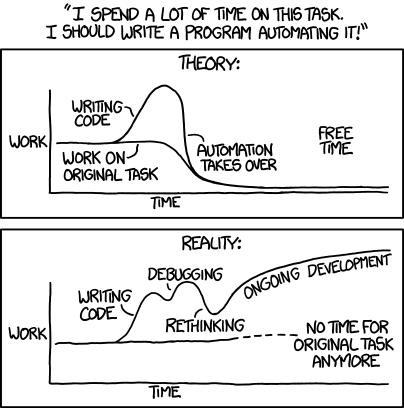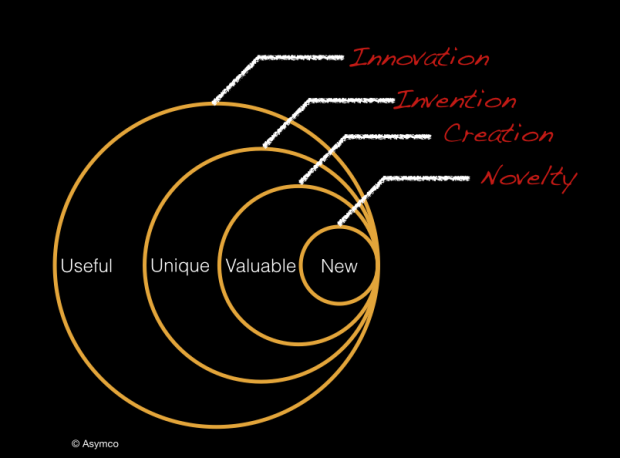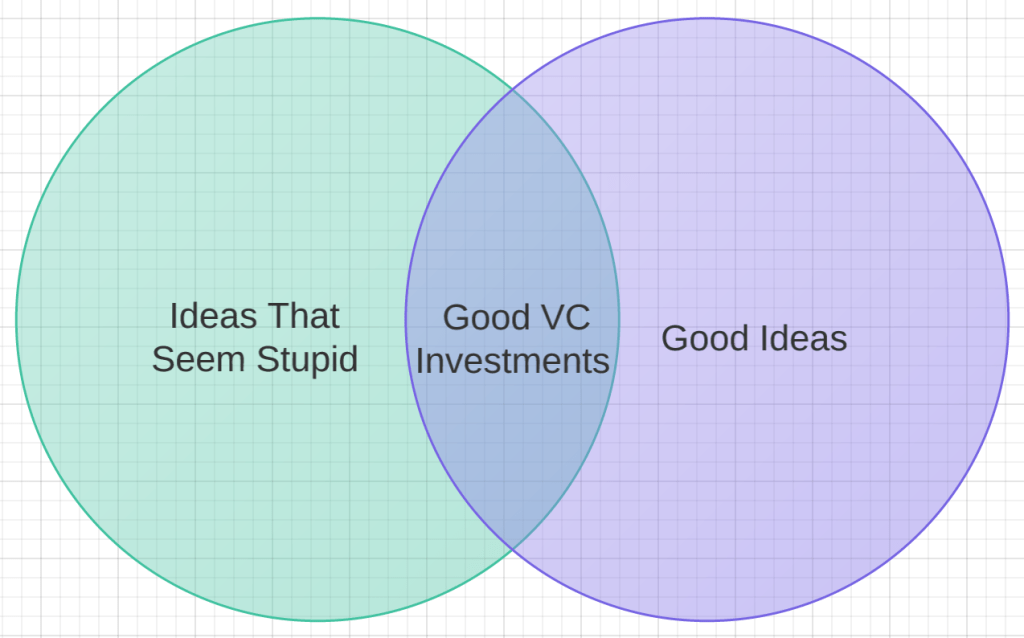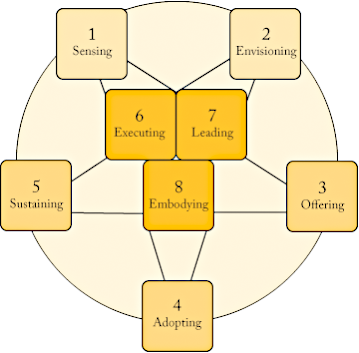Innovation is about finding a better way of doing something. Like many of the new development buzzwords (which many of them are over-used on many business documents), the concept of innovation originates from the world of business. It refers to the generation of new products through the process of creative entrepreneurship, putting it into production, and diffusing it more widely through increased sales. Innovation can be viewed as t he application of better solutions that meet new requirements, in-articulated needs, or existing market needs. This is accomplished through more effective products, processes, services, technologies, or ideas that are readily available to markets, governments and society. The term innovation can be defined as something original and, as a consequence, new, that “breaks into” the market or society.
Innoveracy: Misunderstanding Innovation article points out that there is a form of ignorance which seems to be universal: the inability to understand the concept and role of innovation. The way this is exhibited is in the misuse of the term and the inability to discern the difference between novelty, creation, invention and innovation. The result is a failure to understand the causes of success and failure in business and hence the conditions that lead to economic growth. The definition of innovation is easy to find but it seems to be hard to understand. Here is a simple taxonomy of related activities that put innovation in context:
- Novelty: Something new
- Creation: Something new and valuable
- Invention: Something new, having potential value through utility
- Innovation: Something new and uniquely useful
The taxonomy is illustrated with the following diagram.
The differences are also evident in the mechanisms that exist to protect the works: Novelties are usually not protectable, Creations are protected by copyright or trademark, Inventions can be protected for a limited time through patents (or kept secret) and Innovations can be protected through market competition but are not defensible through legal means.
Innovation is a lot of talked about nowdays as essential to businesses to do. Is innovation essential for development work? article tells that innovation has become central to the way development organisations go about their work. In November 2011, Bill Gates told the G20 that innovation was the key to development. Donors increasingly stress innovation as a key condition for funding, and many civil society organisations emphasise that innovation is central to the work they do.
Some innovation ideas are pretty simple, and some are much more complicated and even sound crazy when heard first. The is place for crazy sounding ideas: venture capitalists are gravely concerned that the tech startups they’re investing in just aren’t crazy enough:
Not all development problems require new solutions, sometimes you just need to use old things in a slightly new way. Development innovations may involve devising technology (such as a nanotech water treatment kit), creating a new approach (such as microfinance), finding a better way of delivering public services (such as one-stop egovernment service centres), identifying ways of working with communities (such as participation), or generating a management technique (such as organisation learning).
Theorists of innovation identify innovation itself as a brief moment of creativity, to be followed by the main routine work of producing and selling the innovation. When it comes to development, things are more complicated. Innovation needs to be viewed as tool, not master. Innovation is a process, not a one time event. Genuine innovation is valuable but rare.
There are many views on the innovation and innvation process. I try to collect together there some views I have found on-line. Hopefully they help you more than confuze. Managing complexity and reducing risk article has this drawing which I think pretty well describes innovation as done in product development:
8 essential practices of successful innovation from The Innovator’s Way shows essential practices in innovation process. Those practices are all integrated into a non-sequential, coherent whole and style in the person of the innovator.
In the IT work there is lots of work where a little thinking can be a source of innovation. Automating IT processes can be a huge time saver or it can fail depending on situation. XKCD comic strip Automation as illustrates this:

System integration is a critical element in project design article has an interesting project cost influence graphic. The recommendation is to involve a system integrator early in project design to help ensure high-quality projects that satisfy project requirements. Of course this article tries to market system integration services, but has also valid points to consider.
Core Contributor Loop (CTTDC) from Art Journal blog posting Blog Is The New Black tries to link inventing an idea to theory of entrepreneurship. It is essential to tune the engine by making improvements in product, marketing, code, design and operations.






5,708 Comments
Tomi Engdahl says:
Why Bell Labs Worked.
Or, how MBA culture killed Bell Labs
https://1517.substack.com/p/why-bell-labs-worked
Tomi Engdahl says:
https://www.dailymail.co.uk/femail/article-14763531/Doctor-air-fryer-throw-out.html
Tomi Engdahl says:
https://www.ecoportal.net/en/solid-light-created-brighter-than-white/8398/
Tomi Engdahl says:
The Microplastics in Your Brain Might Be Making You Depressed
https://www.vice.com/en/article/the-microplastics-in-your-brain-might-be-making-you-depressed/
Tomi Engdahl says:
https://arstechnica.com/gadgets/2017/11/the-underground-story-of-cobra-the-1980s-illicit-handmade-computer/
Tomi Engdahl says:
https://www.vice.com/en/article/this-crazy-side-hustle-culture-is-burning-everyone-out/
Tomi Engdahl says:
https://www.boredpanda.com/cosmetologist-reveals-what-hollywoods-women-would-look-like-without-cosmetics/
Tomi Engdahl says:
https://hbr.org/2025/04/how-people-are-really-using-gen-ai-in-2025?fbclid=IwQ0xDSwKeT3RjbGNrAp5PcmV4dG4DYWVtAjExAAEexwHPBRyv9Gx3cKncRZBcDScGlau41mZutvA8MEr3IOfMeF0hblikGfQaHds_aem_8VW-Zfgnkr_wibSw6z2GWA
Tomi Engdahl says:
https://www.ekathimerini.com/nytimes/1270097/a-new-headache-for-honest-students-proving-they-didnt-use-ai/
Tomi Engdahl says:
https://m.economictimes.com/industry/services/education/is-this-the-era-of-humanities-over-engineering/articleshow/120854151.cms
Tomi Engdahl says:
https://news.harvard.edu/gazette/story/2025/05/i-can-just-copy-paste-things-so-do-i-really-need-to-learn/
Tomi Engdahl says:
https://www.iflscience.com/what-happened-when-scientists-exposed-human-cells-to-5g-absolutely-nothing-79247
Tomi Engdahl says:
5 Jobs For Introverts That Quietly Pay Six Figures
https://www.forbes.com/sites/shodewan/2025/04/02/5-jobs-for-introverts-that-quietly-pay-six-figures/
Tomi Engdahl says:
https://techcrunch.com/2025/05/12/inventwood-is-about-to-mass-produce-wood-thats-stronger-than-steel/
Tomi Engdahl says:
https://www.ecoticias.com/en/light-teleported-reach-another-galaxy/14548/
Tomi Engdahl says:
https://farmingdale-observer.com/2025/05/16/scientists-have-been-studying-remote-work-for-four-years-and-have-reached-a-very-clear-conclusion-working-from-home-makes-us-happier/
Tomi Engdahl says:
https://www.aquatechtrade.com/news/wastewater/5-beers-made-from-recycled-wastewater
https://www.wired.com/story/pissky/
Tomi Engdahl says:
https://dev.to/somadevtoo/12-timeless-books-every-programmer-should-read-3202
Tomi Engdahl says:
https://futurism.com/physicists-wrong-gravity
Tomi Engdahl says:
https://today.yougov.com/society/articles/21717-how-good-good-1
https://yougov.co.uk/society/articles/21568-how-good-good
https://today.yougov.com/society/articles/21717-how-good-good-1?fbclid=IwQ0xDSwKYakljbGNrAphqJmV4dG4DYWVtAjExAAEe8hxYjZDi_j9M-XqV0S6iEe8zzqbyrhO2KdXt3bPaOuvJsBI2YGOqedZKhGk_aem_qD8ivbM3Snbp1vlH9tCS-g
Tomi Engdahl says:
https://www.eeva.fi/jutut/aivotutkija-mona-moisala#Echobox=1747384034
Simppeli oivallus
Aivotutkija Mona Moisala työskentelee vain nelisen tuntia päivässä – nyt hän kertoo, miksi 8 tunnin työpäivä ei toimi kenellekään
Aivotutkija Mona Moisala tietää, että on mahdotonta olla tehokas kahdeksan tuntia putkeen.
Tomi Engdahl says:
https://www.verkkouutiset.fi/a/suomalaisen-yliopiston-lapimurto-syopalaakkeen-teho-voidaan-ennustaa-geeniprofiililla/#9c1dc2d3
Tomi Engdahl says:
https://tekniikanmaailma.fi/puolipiste-kuihtuu-kielesta-nuoret-eivat-osaa-kayttaa-sita/
Tomi Engdahl says:
https://www.housedigest.com/1860609/downsides-ziploc-plastic-sandwich-bags-not-worth-buying-safe-alternatives/
Tomi Engdahl says:
https://glassalmanac.com/first-ever-photo-of-a-single-atom-captured-a-game-changer-for-science/
Tomi Engdahl says:
https://www.bbc.com/future/article/20250516-the-people-stuck-using-ancient-windows-computers
Tomi Engdahl says:
https://www.earth.com/news/mathematicians-may-have-solved-a-125-year-old-problem-linking-the-laws-of-physics/
Tomi Engdahl says:
https://okdiario.com/metabolic/en/psychology/personal-development-and-self-help/neither-science-nor-math-the-subject-that-sharpens-childrens-minds-but-is-often-overlooked-in-the-usa-13296/
Tomi Engdahl says:
Dissolvable battery that could make Mission Impossible’s self-destructible device developed
The device creates power sources that disappear without leaving toxic residues behind.
https://interestingengineering.com/energy/dissolvable-battery-developed-with-probiotics
Tomi Engdahl says:
https://etn.fi/index.php/13-news/17618-ensimmaeistae-kertaa-mikroaaltojen-fotonipiiri-yhdellae-sirulla
Tomi Engdahl says:
Saving Green Books From Poison Paranoia
https://hackaday.com/2025/06/09/saving-green-books-from-poison-paranoia/
You probably do not need us to tell you that Arsenic is not healthy stuff. This wasn’t always such common knowledge, as for a time in the 19th century a chemical variously known as Paris or Emerald Green, but known to chemists as copper(II) acetoarsenite was a very popular green pigment. While this pigment is obviously not deadly on-contact, given that it’s taken 200 years to raise the alarm about these books (and it used to be used in candy (!)), arsenic is really not something you want in your system. Libraries around the world have been quarantining vintage green books ̶f̶o̶r̶ ̶f̶e̶a̶r̶ ̶b̶i̶b̶l̶i̶o̶p̶h̶i̶l̶i̶es ̶m̶i̶g̶h̶t̶ ̶b̶e̶ ̶t̶e̶m̶p̶t̶e̶d̶ ̶t̶o̶ ̶l̶i̶c̶k̶ ̶t̶h̶e̶m̶ out of an abundance of caution, but researchers at The University of St. Andrews have found a cheaper method to detect the poison pigment than XRF or Raman Spectroscopy previously employed.
The hack is simple, and in retrospect, rather obvious: using a a hand-held vis-IR spectrometer normally used by geologists for mineral ID, they analyzed the spectrum of the compound on book covers.
New tool to identify ‘toxic’ green books
https://news.st-andrews.ac.uk/archive/new-tool-to-identify-toxic-green-books/
Tomi Engdahl says:
Information Density: Microfilm And Microfiche
https://hackaday.com/2025/06/09/information-density-microfilm-and-microfiche/
Today, we think nothing of sticking thousands of pages of documents on a tiny SD card, or just pushing it out to some cloud service. But for decades, this wasn’t possible. Yet companies still generated huge piles of paper. What could be done? The short answer is: microfilm.
However, the long answer is quite a bit more complicated. Microfilm is, technically, a common case of the more generic microform. A microform is a photographically reduced document on film. A bunch of pages on a reel of film is microfilm. If it is on a flat card — usually the size of an index card — that’s microfiche. On top of that, there were a few other incidental formats. Aperture cards were computer punch cards with a bit of microfilm included. Microcards were like microfiche, but printed on cardboard instead of film.
In its heyday, people used specialized cameras, some made to read fanfold computer printer paper, to create microfilm. There were also computer output devices that could create microfilm directly.
How Did That Happen?
Although microfilm really caught on in the mid-20th century, it is much older than that. John Benjamin Dancer appears to have been the first to reduce documents by about 160:1 using daguerreotypes in 1839. He also used wet collodion plates later, but didn’t see any real point to the work.
There were many less-than-successful attempts to bring microfilm into the hands of readers.
Like many great ideas, there wasn’t a single point where the perfect machine appeared. It was more of a slow ooze. There was clearly a need to compress stored documents. It just needed the right equipment.
Equipment and Film
Early microforms were projected with conventional equipment like a magic lantern or eyeballed with a magnifier. However, modern readers generally project onto the rear of a glass screen. More expensive ones could even print what was on the screen using a photocopier-like mechanism.
Film reels tend to be either 16 mm or 35 mm, and some machines could do either. Typically, 35 mm microfilm was the order of the day for large-format scans. Letter-sized material commonly went on 16 mm film. Sometimes the film was on an open reel. Other times, it would be in a cartridge. There were M-type cartridges and ANSI cartridges (and probably others).
Either way, the film could have a single image per frame (simplex) or two images, such as the front and back of a document, per frame. That’s a duplex microfilm.
Some systems used “blips” at the edge of the film to mark when an image starts so that all the pages don’t have to be the same size.
Super fancy machines used a double blip to mark the start of a document. This allows you to refer to “roll 295, document 3, frame 80” or — more commonly — to tell the machine to skip to the next document.
Microfiche cards varied somewhat, but were normally very close to 4×6 inches. Jacket versions held strips of film, but specially-made microfiche cards might be just a single sheet of film.
Microfilm Today
Most things today are in digital form and a great deal of old microform records are now in digital form, too. However, there was such a flood of microforms that there are still records that you need to find a reader to see them. The Internet Archive, as you might expect, digitizes a lot of microform documents and, if you are watching at the right time, you can look over their shoulder while they do it.
Of course, in addition to military mail, extreme microfilm works for spies, too. If you find a cache of microfiche cards, you can always build your own reader.
This Expedient Microfiche Reader Illuminates Retro Datasheets
https://hackaday.com/2020/12/20/this-expedient-microfiche-reader-illuminates-retro-datasheets/
You have to be of a certain vintage to remember doing research on microfilm and microfiche. Before the age of mass digitization of public records, periodicals, and other obscure bits of history, dead-tree records were optically condensed onto fine-grain film, either in roll form or as flat sheets, which were later enlarged and displayed on a specialized reader. This greatly reduced the storage space needed for documents, but it ended up being a technological dead-end once the computer age rolled around.
Tomi Engdahl says:
https://hackaday.com/2025/06/10/what-marie-curie-left-behind/
Tomi Engdahl says:
Uutta tietoa ultraprosessoidusta ruoasta: Voi heikentää aivojen toimintaa
Ultraprosessoitu ruoka saattaa vaikuttaa aivoihin ja johtaa myös ylensyöntiin.
https://www.iltalehti.fi/terveysuutiset/a/20736865-a76e-43e0-a31b-5c62dc1d8092
Tomi Engdahl says:
Ultra-processed food consumption affects structural integrity of feeding-related brain regions independent of and via adiposity
https://www.nature.com/articles/s44324-025-00056-3
Abstract
Consumption of ultra-processed foods (UPFs) increases overall caloric intake and is associated with obesity, cardiovascular disease, and brain pathology. There is scant evidence as to why UPF consumption leads to increased caloric intake and whether the negative health consequences are due to adiposity or characteristics of UPFs. Using the UK Biobank sample, we probed the associations between UPF consumption, adiposity, metabolism, and brain structure. Our analysis reveals that high UPF intake is linked to adverse adiposity and metabolic profiles, alongside cellularity changes in feeding-related subcortical brain areas. These are partially mediated by dyslipidemia, systemic inflammation and body mass index, suggesting that UPFs exert effects on the brain beyond just contributing to obesity. This dysregulation of the network of subcortical feeding-related brain structures may create a self-reinforcing cycle of increased UPF consumption.
Tomi Engdahl says:
CAFFEINE AND THE SLEEPING BRAIN — Adenosine molecules gradually build up in the brain during the day, leading to a greater feeling of fatigue as bedtime approaches. Caffeine works by blocking the receptors that adenosine interacts with, giving us a temporary jolt of energy.
Adenosine receptors are more abundant in younger brains, which may explain why younger people seem to be more sensitive to caffeine’s powers. That includes both the positive energizing effects, and the negative effects of keeping the brain too active overnight.
“Caffeine is a psychoactive stimulant that is consumed by people across all age groups on a daily basis through a wide variety of products such as coffee, tea, soft drinks, energy drinks, chocolate, and several pharmaceutical drugs,” write the researchers in their published paper.
Caffeine Has a Weird Effect on Your Brain While You’re Asleep
https://www.sciencealert.com/caffeine-has-a-weird-effect-on-your-brain-while-youre-asleep?fbclid=IwY2xjawK6xO5leHRuA2FlbQIxMQABHnipGLhq7IGiw1X-FswZnK9WcnRsmwySAGWPMVUxS21auXcuLWP6nHA882Jj_aem_B14jaWoC7AC8BTs2tdVjWw
We already know that the stimulating powers of caffeine make it an unsuitable choice for a late-night drink – at least if you want to get any shut-eye. But a new study adds a whole extra level of detail to our understanding of caffeine’s impact on the brain during sleep.
Tomi Engdahl says:
Dyson surprised everyone in 2022 when it took its first steps into audio and wearable technology with a strange experiment, the Dyson Zone, over-ear headphones that also functioned as a personal air purifier. With COVID-era masks in the rearview for many of us now, however, the company is discontinuing its Bane-like device.
Many retailers have already stopped sales, though you can still pick one up on Woot for $259.99, a pretty big price cut from its original selling price of $949.99.
Jake Dyson, Chief Engineer at Dyson, tells Wired that the “Zone was completely ahead of its time.” It solved a “niche” problem at the time. However, the “amount of people that are neurotic about air pollution, that want to solve that problem, and are willing to spend an amount of money; coupled with the fact that it’s headphones, means your market is small.”
More at PCMag
https://www.pcmag.com/news/dyson-discontinues-its-bizarre-zone-air-purifier-headphones
Tomi Engdahl says:
Tämä kaikki kehossasi tapahtuu, jos syöt mansikoita joka päivä
Mansikat auttavat hillitsemään makeanhimoa, tukevat sydänterveyttä, parantavat muistia, edistävät suolen toimintaa ja voivat jopa piristää seksielämää.
https://www.iltalehti.fi/ruoka-artikkelit/a/bc4ea44b-8aca-4749-97dd-176df05f8c06
Mansikkakausi on Suomessa käynnistynyt perinteisesti juhannuksen aikoihin.
Jos pohdit, voiko pian sesongissa olevaa herkkumarjaa napostella joka päivä, vastaus on kyllä. Se on jopa suositeltavaa!
Kokonaiskuva ratkaisee
Vaikka marjoja onkin suositeltavaa syödä päivittäin, kokonaisvaltainen ja monipuolinen ruokavalio on tärkeä.
Suositus on syödä runsaasti erilaisia kasviksia, hedelmiä sekä marjoja.
Tomi Engdahl says:
https://etn.fi/index.php/13-news/17646-hengittaevae-akku-on-askeleen-laehempaenae
Tomi Engdahl says:
https://etn.fi/index.php/13-news/17647-mullistava-muunninpiiri-nostaa-datansiirron-nopeuden-kolminkertaiseksi
Belgialainen mikroelektroniikan tutkimuskeskus IMEC on esitellyt digitaalista datansiirtoa mullistavan uutuuden. 150 giganäytetty sekunnissa näytteistävä DA-muunnin 300 gigabitin tiedonsiirtoon sekunnissa yhdellä kaistalla. Tämä on merkittävä harppaus verrattuna nykyisiin markkinoilla oleviin PAM-4-pohjaisiin ratkaisuihin.
Tomi Engdahl says:
https://etn.fi/index.php/13-news/17651-vtt-kehitti-maatuvan-aurinkokennon-maatalouteen
https://www.uusiteknologia.fi/2025/06/17/biohajoavat-pienaurinkokennot-avuksi/
Tomi Engdahl says:
Fries and ketchup from one plant imagine that
https://simple.wikipedia.org/wiki/Pomato
https://www.euronews.com/green/2021/07/28/you-say-potato-i-say-pomato-hybrid-plants-could-make-it-easier-to-grow-more-food
Tomi Engdahl says:
Saimaannorppa on Saimaatakin vanhempi
Saimaannorppa on Saimaatakin vanhempi
Tuore tutkimus paljastaa, että saimaannorppa on evolutiivisesti selvästi eriytyneempi kuin aikaisemmin on tiedetty. Tutkijat ehdottavatkin, että alalajin sijasta saimaannorpan tulisi olla oma itsenäinen lajinsa.
https://www.helsinki.fi/fi/uutiset/evoluutio/saimaannorppa-saimaatakin-vanhempi?utm_source=facebook&utm_campaign=social_owned&fbclid=IwZXh0bgNhZW0BMABhZGlkAAAGQC4qbrwBHuzUAKYNukSpxLHrMMr7T3hEEd0hD4fxcsPm_2gFZPxPvXZdDSplKjdqY9Hi_aem_2pl2o1LCwptpJnOeTSkeRA&utm_medium=paid&utm_id=6567101323596&utm_content=6872707365796&utm_term=6872707365396
Tuore tutkimus paljastaa, että saimaannorppa on eriytynyt muista norpista jo yli 60 000 vuotta sitten – siis paljon ennen 10 000 vuotta sitten tapahtunutta Saimaan syntyä.
Siinä missä Itämeren ja Laatokan norppien alkuperä on Atlantilla, saimaannorpat ovat todennäköisesti levittäytyneet Suomen alueelle idästä – alueelta, jossa jääkauden aikana esiintyi laajoja jääjärviä.
Tutkijat ehdottavatkin, että alalajin sijasta saimaannorpan tulisi olla oma itsenäinen lajinsa.
Tomi Engdahl says:
Perovskite image sensor catches 3x more light, could transform cameras, medical imaging
Apart from cameras, the perovskite sensor is ideal for medical diagnostics and automated monitoring in agriculture and environmental systems.
https://interestingengineering.com/innovation/perovskite-sensor-captures-3x-more-light?utm_campaign=&utm_medium=article_post&utm_source=Facebook&fbclid=IwY2xjawLBwI1leHRuA2FlbQIxMQABHopzj-JFD3lgBNQGvB7sdBHhDwBFwUvG0A4EXOCwgi70K_fUKJIZXw7LQtGJ_aem_wgw7ftZsZaVJ7mXS8cxg-A
Researchers in Switzerland have created a new perovskite-based image sensor that outperforms conventional silicon sensors in nearly every category, including light sensitivity, resolution, color accuracy, and adaptability for machine vision.
The innovative sensor, which reportedly holds the potential to revolutionize not only digital photography but also medical diagnostics and environmental monitoring, was developed by Maksym Kovalenko, PhD, a professor of functional inorganic materials at ETH Zurich, and his research team.
Unlike traditional sensors that rely on filters to detect color, which ultimately results in significant light loss, the new designs use stacked perovskite layers, each tuned to absorb a specific portion of the visible spectrum.
This unique mechanism allows each pixel to capture the full range of incoming light, thus significantly enhancing image clarity and color precision while reducing common digital artifacts.
Silicon has dominated the image sensor industry for decades, powering nearly every smartphone and digital camera and distinguishing colors in a way similar to the human eye.
However, traditional silicon sensors have a fundamental limitation as they use color filters to separate red, green, and blue (RGB) light, which means each pixel captures only about one-third of the available photons. This ultimately reduces efficiency and image quality.
By adjusting the mix of iodine, bromine, and chlorine ions in the perovskite crystal, researchers can target specific wavelengths of light, while allowing other wavelengths to pass through.
For example, if the perovskite contains more iodine ions, it absorbs red light. To absorb green, the researchers add more bromine, and for blue, more chlorine, all without the need for filters.
While the current prototypes have pixel sizes ranging from 0.5 to 1 millimeter, which is much larger than the micrometer-scale pixels in commercial sensors, the researchers believe perovskite pixels can be made even smaller than those in silicon-based devices. Achieving this will require a redesign of supporting electronics, which are currently optimized for silicon’s material properties.
“It should be possible to make even smaller pixels from perovskite than from silicon,” Yakunin said, explaining that the electronic connections and processing techniques need to be adapted for the new technology.
“Today’s readout electronics are optimized for silicon,” Kovalenko concluded in a press release. “But perovskite is a different semiconductor, with different material properties.”
Tomi Engdahl says:
https://glassalmanac.com/first-ever-photo-of-a-single-atom-captured-a-game-changer-for-science-2/
Tomi Engdahl says:
Chinese researchers invent silicon photonic multiplexer chip that uses light instead of electricity for communication — CCP says China’s early steps into light-based chips precede ‘major breakthroughs’ in three years
https://www.tomshardware.com/tech-industry/semiconductors/chinese-researchers-invent-silicon-photonic-multiplexer-chip-that-uses-light-instead-of-electricity-for-communication-ccp-says-chinas-early-steps-into-light-based-chips-precede-major-breakthroughs-in-three-years
Tomi Engdahl says:
“The world has begun an unprecedented decline in fertility rates.” https://trib.al/Onlq29Y
Tomi Engdahl says:
“Who says pie charts aren’t useful?” https://trib.al/QXHrjFw
Tomi Engdahl says:
This action was “previously thought impossible.” https://trib.al/uJh0VVw
Tomi Engdahl says:
“Three years earlier provides time for intervention.” https://trib.al/Nx11NYo